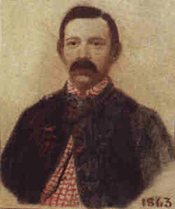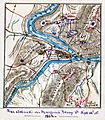Robert Knox Sneden facts for kids
Robert Knox Sneden (born 1832, died 1918) was an American artist. He painted landscapes and made maps for the Union Army during the American Civil War. He was known for drawing and writing a lot about the war and other important events.
Contents
Robert Sneden's Early Life
Robert Knox Sneden was born in Annapolis Royal, Nova Scotia, Canada. When he was 19, in 1851, he moved to New York City. He also studied architecture for a while.
Serving in the Civil War
In 1861, Sneden left Brooklyn to join the army. He became part of the 40th New York Volunteer Infantry Regiment, also known as the Mozart Regiment. This group was part of the Army of the Potomac.
He worked as a quartermaster, helping to manage supplies, when his regiment was camped near Leesburg Turnpike. Starting in January 1862, Sneden joined the staff of Samuel P. Heintzelman's III Corps. At first, he drew maps. Later, he became a topographical engineer, which means he helped create detailed maps of the land.
In March 1862, Sneden went with Heintzelman for the Peninsula Campaign. He was involved in several battles, including the Battle of Williamsburg, Battle of Seven Pines, Battle of Savage's Station, and Battle of Glendale. After these battles, he returned to Northern Virginia. There, he took part in the Second Battle of Bull Run. He was then assigned to help defend Washington, D.C., first in Alexandria, Virginia, and then at Arlington House.
In October 1863, after the Battle of Bristoe Station, he was assigned to David B. Birney's division. He participated in the Battle of Kelly's Ford. He also worked for General William H. French during the Battle of Mine Run, which was a battle that didn't go as planned.
Life as a Prisoner of War
On November 27, 1863, Sneden was captured by Confederate rangers led by John S. Mosby. He became a prisoner of war for the next 13 months.
In November 1863, he was held in a tobacco warehouse next to Libby Prison. He became very sick there. On February 22, 1864, after some prisoners tried to escape, Sneden and others were moved to a new camp in Georgia.
Sneden was sent to the famous Andersonville Prison. Even there, he secretly continued to make drawings. He sketched scenes of prison life in places like Savannah and Millen, Georgia. He also drew scenes from prisons in Florence and Charleston, South Carolina. Finally, on December 11, 1864, he was released in Charleston as part of a prisoner exchange.
Robert Sneden's Later Life
After the Civil War, Sneden returned to Brooklyn. People there had thought he was dead or missing. Even though he was weakened from his time in Andersonville, he started turning his war sketches into watercolor paintings. He left behind nearly 1,000 watercolors, drawings, sketches, maps, and diagrams.
Sneden shared some of his work with Battles and Leaders of the Civil War. This was a series of articles published between 1884 and 1887 in The Century Magazine. Later, these articles were put together into a four-book set.
Sneden never got married. He spent the rest of his life making sure people remembered the Civil War. In 1918, he passed away at the New York State Soldiers' and Sailors' Home.
How Robert Sneden Was Recognized
In 1994, an art dealer found a collection of Civil War items that had been stored in a bank vault in Connecticut. This collection belonged to Robert Sneden. His great-great-nephew also sold Sneden's diary and watercolors to the Virginia Historical Society. This included almost 5,000 pages of diary entries and memories, plus nearly 500 watercolors and maps.
In the fall of 2000, Sneden became well-known to the public and Civil War fans. This happened when about 300 of his artworks were shown in an exhibition called Eye of the Storm. A book about the exhibition also became a bestseller. The Virginia Historical Society said it was "the largest collection of [American] Civil War soldier art ever produced." Sneden's drawings are seen as very important historical records because they show what happened during the war.
Today, his works are kept at the Virginia Historical Society. You can also find them through the Library of Congress.
-
Fort Monroe, 1865
-
A restored version of Sneden's map for the Battle of Harpers Ferry











